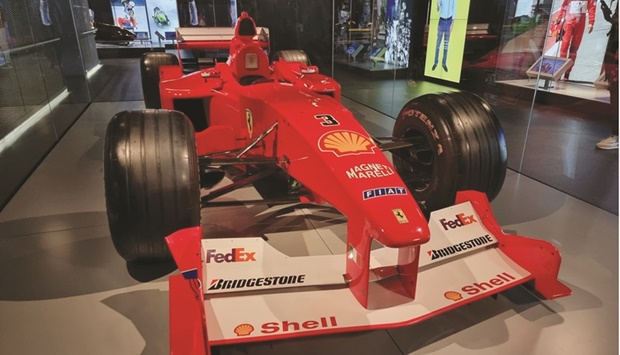This is the first museum in the Middle East dedicated to achievement in sports, says HE Sheikha Al Mayassa
Qatar Museums (QM) puts a spotlight on sports and the Olympic Games’ rich history and legacy with the opening on Wednesday of one of the world’s most innovative and technologically advanced museums dedicated to sports.
Under the patronage of His Highness the Amir Sheikh Tamim bin Hamad al-Thani, Qatar Museumson Wednesday unveiled the 3-2-1 Qatar Olympic and Sports Museum, during an official opening ceremony held at Khalifa International Stadium.
HE Sheikha Al Mayassa bint Hamad bin Khalifa al-Thani, Chairperson of Qatar Museums, delivered remarks at the inauguration.

One of the bats used by Indian cricket legend Sachin Tendulkar. PICTURES: Joey Aguilar

The basketball autographed by the US Dream Team during the 1992 Olympics qualifying tournament.
The 3-2-1 Qatar Olympic and Sports Museum offers interactive exhibits and an array of rare and notable collections that celebrate the achievements of sports, athletes and the Olympics.
HE Sheikha Al Mayassa said, “This is the very first museum in the Middle East dedicated to achievement in sports, to exploring the profound role of sports in society and in our personal lives, and is the only Arab institution to join the international Olympic Museums Network.
“In doing so, we demonstrate Qatar’s commitment to the ideals of the modern Olympic Movement, which recognises the potential for athletic competition to lift the spirit, foster co-operation among people, and encourage a healthy and productive way of life.”
3-2-1 is the newest member of the Olympic Museums Network and one of the world’s most innovative and technologically advanced museums dedicated to sports, offering an unforgettable and inspiring interactive journey through the history and legacy of sports around the globe and the Olympic Games. Through its interactive spaces and programming, 3-2-1 aims to inspire and engage its visitors and encourage the public to participate in sports and physical activity.
Designed by Spanish architect Joan Sibina, the museum is spread over approximately 19,000sq m and is built onto Khalifa International Stadium, part of Aspire Zone Foundation, making it one of the largest of its kind.

The boxing glove (left hand) used by Cassius Clay (Muhammad Ali) in 1960 during the Olympic Games in Rome – where he bagged the gold medal in the heavyweight category.

The museum showcases the achievements of sporting legends such as Filipino boxer Manny Pacquiao.
The stadium, originally constructed in 1976, will host FIFA World Cup Qatar 2022 matches.
Sheikh Mohamed bin Abdullah bin Mohamed bin Ali al-Thani, President, 3-2-1 Qatar Olympic and Sports Museum, said: “3-2-1 — the newest edition to Qatar Museums’ network — supports the human development pillar of the Qatar National Vision 2030, underscoring the integral role of sports in nurturing human capital and securing a prosperous and sustainable future. In recent years, Qatar has cemented its role as a major international sporting hub and the unveiling of 3-2-1 Qatar Olympic and Sports Museum is an incredibly proud and accomplished moment for us at Qatar Museums.”
“It is an immense honour to celebrate Qatar’s sporting culture and to support the country in furthering its ambitions as a major contributor to sustainable sports development,” he added.
Qatari world champion Nasser bin Saleh al-Attiyah told Qatar News Agency that 3-2-1 Qatar Olympic and Sports Museum is the second largest museum in the world. “We are proud when we see our achievements, which will give the younger generation a boost and a great push to achieve what we have accomplished and more.”
Speaking about the documentation of his legacy in major world championships at 3-2-1 Qatar Olympic and Sports Museum, al-Attiyah said: “This means a lot to me... I am watching a journey of nearly 28 years of giving, achievements and fatigue.”
At a recent press preview of the museum, HE Sheikha Al Mayassa said: “This is the first Arab institution to become part of the Olympic Museum Network, joining Qatar to other nations around the world in a shared commitment to the values of a modern Olympic movement.” She was joined by 3-2-1 president Sheikh Mohamed and director Abdulla al-Mulla.
“As the founder of the modern Olympic Games, Pierre de Coubertin, once wrote: ‘the most important thing in the Olympic Games is not winning but taking part, the essential thing in life is not conquering but fighting well’. This is an ideal that we both honour and put into practice at the 3-2-1 Qatar Olympic and Sports Museum, making this an institution of the highest significance.”
Some of the highlights include the boxing glove (left hand) used by Cassius Clay (Muhammad Ali) in 1960 during the Olympic Games in Rome – where he bagged the gold medal in the heavyweight category.
HE Sheikha Al Mayassa said, “These are particularly meaningful to the people of Qatar who still remember how Ali came here in 1971 on a tour of the Middle East and fought in an exhibition bout at the Doha Stadium, the first grass stadium in the Middle East.”
The QM Chairperson noted that each object in the collection at the museum has its own story to tell, such as the trophy won by His Highness the Amir when he was a tennis champion.
“Another iconic object that captured the historic moment is the jumpsuit worn by Nawal El Moutawakel at the 1984 Olympics in Los Angeles when she thrilled Muslim Arab and female athletes around the world by winning the very first women’s 400m hurdles (event) in the Olympics,” she added.
Other items on display include the Formula 1 car that Michael Schumacher drove in 2000, and the basketball autographed by the US Dream Team during the 1992 Olympics qualifying tournament. The team included sporting legends like Michael Jordan, Magic Johnson, Larry Bird, Patrick Ewing, Clyde Drexler and Scottie Pippen, among others.
“The opening of the 3-2-1 Qatar Olympic and Sports Museum alongside the FIFA Congress is a symbol of the importance of sports in Qatar National Vision 2030. The museum belongs to the Olympic Museums Network, and is a legacy project of the Doha Asian Games 2006.
“The 3-2-1 Qatar Olympic and Sports Museum, comes after Qatar’s outstanding performance at the Tokyo Olympics, and just before we host the World Cup in November 2022. Culture and sports are two sides of the same coin, and there is no better time to celebrate our nation’s investments in both culture and sports – two pillars that also support Qatar’s investments in Education and Health.
“The opening promises to celebrate the Qatari athletes with the world; a testament of the leadership of His Highness the Amir in focusing on developing people in all fields,” HE Sheikha Al Mayasa said in a statement.
Through its participatory spaces and programming, QM noted that 3-2-1 aims to inspire and engage its community and encourage the public to take part in sports and physical activity.
The Olympic Foundation for Culture and Heritage director and Olympic Museum Network (OMN) chair Angelita Teo said, “Having the brand new 3-2-1 Qatar Olympic and Sports Museum join the Olympic Movement in promoting the Olympic Games and Olympic Values is a great source of excitement. I send my best wishes to the management and operating teams for the culmination of this ambitious project, and I hope to visit it in the near future.”
HE Sheikh Mohamed said Qatar cemented its role as a major international sporting hub in recent years, hosting more than 500 key sporting events such as football, tennis, table tennis, athletics, gymnastics and swimming, among other major international competitions, over the past 15 years.
The 3-2-1 director noted that 3-2-1 comprises seven gallery spaces, housing objects from around the globe, and from the origins of sports to the present day.
Generous support has been provided by the Qatar Olympic Committee, Aspire Zone Foundation, Supreme Committee for Legacy & Delivery and Olympic Museums Network. The opening of 3-2-1 is sponsored by Ooredoo.





